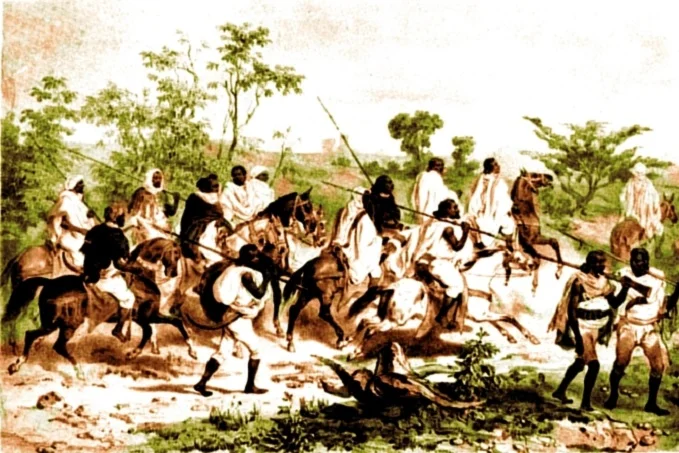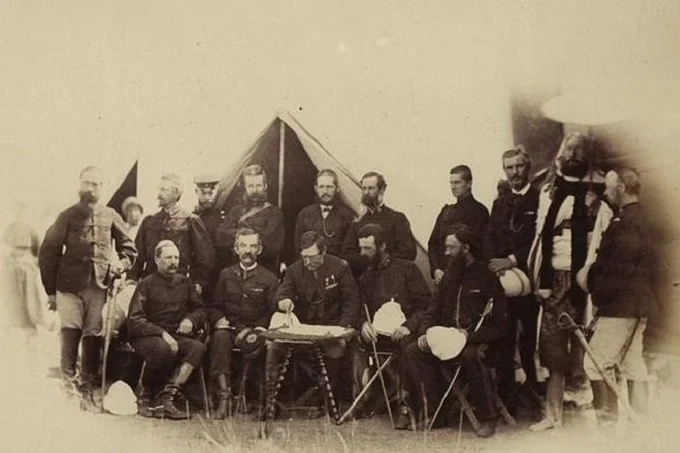How did Ethiopia resist colonization?

The Addis Ababa Treaty was signed on October 23, 1896, between Italy and Ethiopia. The vanquished Italians had no option but to declare Ethiopia’s independence and renounce their colonial ambitions in the area.
A thousand-year-old African kingdom, Abyssinia defied a much more sophisticated modern army and became Africa’s first and only state to break away from European colonization. The whole European community was stunned by this happened. Until Mussolini in the 1930s, no other foreign force invaded Abyssinia.
Ethiopia was in the midst of Zemene Mesafint, or “the period of princes,” at the turn of the nineteenth century. This time was marked by extreme instability and constant civil conflict among the Gondarin dynasty’s multiple claims to the throne, in which powerful aristocratic families vied for dominance.
For ages, Ethiopia has maintained close connections with European Christian powers, particularly Portugal, which in the 16th century aided the Abyssinian monarchy in its war against its Muslim neighbors. Abyssinia was increasingly closed to foreign presence during the end of the 17th and 18th centuries, though.
The fundamental cause for foreign forces’ increasing invasion was the Zemene Mesafint’s instability. A British expedition acquired access to a port on the Red Sea in 1805, preventing prospective French development in the region. Ethiopia served as a crucial strategic location for Britain during the Napoleonic Wars, allowing it to oppose possible French expansion in North Africa and the Middle East. Many other foreign nations formed links with Abyssinia after Napoleon’s defeat, notably the Ottoman Empire via its vassals in Egypt, France, and Italy.

With Thewodros II’s ascension to the throne in 1855, the age of princes came to an end. The latter deposed the Gondarin ruler, reestablished central control, and put down any lingering rebellions. Tewodros II intended to modernize his government and army after establishing his control, enlisting the support of international specialists.
During his reign, Ethiopia gradually stabilized and underwent minor changes. However, Tewodros II still faced opposition, especially in the Northern Tigray region, which the British Empire supported. These tensions led to the first direct foreign intervention in Ethiopia, the British Expedition to Abyssinia in 1867.
A British military expedition to Ethiopia was launched in December 1867 with the goal of freeing British missionaries imprisoned by Emperor Thewodros II. Faced with a series of Muslim uprisings throughout his realm, Alexander attempted to recruit the assistance of Britain, but owing to tight links with the Ottoman Empire, London refused and even aided the emperor’s opponents. Tewodros II imprisoned numerous British officials and missionaries to discourage what he considered as a betrayal of Christendom. London sent its Bombay army, headed by Lieutenant General Sir Robert Napier, after many unsuccessful discussions.

With the help of Dajamach Kassai, the Solomonid monarch of Tigray, the British troops landed at Zula, present-day Eritrea, and moved steadily towards Magdala. The expeditionary army arrived at Magdala in April, when the British and Ethiopians fought a fight.
British troops with superior guns and heavy infantry annihilated the Abyssinian army. Thousands of people died in Tevodros’ army. Napier’s army had just twenty men, two of whom were critically wounded.
Napier requested the release of all captives and the emperor’s total surrender while besieging the stronghold. Tewodros II intended to commit suicide by refusing to submit to a foreign army after freeing the hostages.
Meanwhile, British troops invaded the city, only to discover the emperor’s corpse. Dajamach Kassai was then enthroned as Yohannes IV, while British soldiers fled to Zula. Britain opted to transfer its forces elsewhere rather than colonize Ethiopia, promising the new emperor a significant amount of money and sophisticated armaments that Abyssinia would need to repel any future foreign incursion.

The Abyssinian Empire’s initial meeting with European powers ended in tragedy. Their forces were annihilated, and the nation was ravaged by massive uprisings. The British, on the other hand, did not establish a permanent occupying force during their departure. They simply assisted Yohannes of Tigray in seizing the throne as a gesture of appreciation for his assistance in the struggle against Tewodros II.
Yohannes IV was a descendant of the Gondarine dynasty and a member of the House of Solomon. Yohannes crushed local disturbances made alliances with the strong Negus Menelik of Shewa, and brought all of Ethiopia under his rule by 1871, claiming descent from the fabled Jewish monarch.
Alula Engeda, one of the new emperor’s most competent generals, was entrusted to head the army. Other would-be attackers, especially the Ottoman Empire and its client state Egypt, were tempted by the recent setback.
Since 1805, Egypt has been totally independent of its masters, owing only de facto loyalty to the sultan. During the reign of Yohannes IV, Ismail Pasha, a Khedive, governed a vast empire that stretched from the Mediterranean to Ethiopia’s northern frontiers, as well as some lands in Eritrea. He wanted to extend his holdings even further and control the whole Nile River, which began in Abyssinia.

In the autumn of 1875, Egyptian forces headed by Arakil Bey invaded Ethiopian Eritrea. The Egyptians were not expecting to be attacked by their superior Abyssinian forces at Gundet, a tiny mountain pass, since they were confident in their triumph.
Despite having sophisticated weapons and powerful artillery, the Egyptians were unable to counterattack because the Abyssinians struck aggressively from the heights, negating the efficacy of weaponry. The invading expeditionary army was completely annihilated. Thousands of Egyptians were killed, and the enemy gained control of innumerable artillery pieces.
The Egyptians attempted another invasion on Ethiopian Eritrea in March 1876, after their terrible loss at Gundet. The invading troops landed on the Gura Plain, near Eritrea’s modern city, under the leadership of Ratib Pasha.
In Egypt, there were roughly 13,000 troops and numerous American advisors, notably former Confederate Brigadier General William Loring. Ratib Pasha constructed two forts in the valley, each with a garrison of 5,000 troops. The remainder of the army was moved ahead only to be besieged by Abyssinian soldiers headed by Alula Engeda almost immediately.
During the months between the two conflicts, the Ethiopian army was not inactive. The Abyssinian forces learned to utilize modern rifles under the direction of Alula Engeda and were able to deploy ten thousand riflemen on the battlefield. Alula was able to quickly encircle and beat the invading Egyptians because of his skilled squads.
From inside the erected forts, Ratib Pasha attempted to preserve his position. The Egyptian commander was forced to flee due to the Abyssinian army’s persistent onslaught. Despite the orderly military retreat, the Khedive lacked the resources to prolong the war and was forced to relinquish his southern expansionist objectives.
Yohannes IV’s position as emperor was bolstered by the victory at Gura, and he remained Ethiopia’s only ruler until his death in 1889. Despite the fact that Yohannes’ son Mengesha Yohannes was declared heir, Yohannes’ ally, Menelik Negus of Shewa, acquired the Ethiopian nobility’s and chieftains’ support. Despite Egypt’s loss, foreign colonial aspirations in the area remained unabated. Italy, which was establishing a colonial empire on the Horn of Africa, made its expansionist aspirations apparent very quickly.
Many local chiefs and rulers, known as “Ras,” challenged Menelik’s ascension to power. On the other hand, the latter was able to recruit the help of Alula Engeda and other aristocratic aristocrats. The new emperor was greeted with one of Ethiopia’s worst famines as soon as he assumed office.
Over a third of the Abyssinian population was killed during this terrible calamity, which lasted from 1889 to 1892. Furthermore, the new emperor attempted to establish favorable ties with neighboring colonial powers, like Italy, with whom he signed the Treaty of Wuchale in 1889. In return for Italy’s acceptance of Abyssinian independence, Ethiopia acknowledged Italian control over Eritrea in the pact.
Menelik II shifted his focus to domestic concerns when his ties with his neighbors had stabilized. He took on the tough job of completing Ethiopia’s modernization. One of his first steps was to consolidate power in Addis Ababa, his new capital. In addition, he established European-style ministries and upgraded the army totally. His efforts, however, were hampered by the worrying acts of his Italian neighbors, who made no attempt to disguise their desire to expand deeper in the Horn of Africa.

As Ethiopia progressed, Italy made strides along the Horn of Africa’s coast. Following the union of the Italian states under the control of the House of Savoy in 1861, this newly formed European monarchy sought to establish a colonial empire in the mold of France and Great Britain. In 1869, Italy purchased the port of Assab in Eritrea from the native sultan, and by 1882, it had taken control of the whole nation. In 1889, Italy also colonized Somalia.
Ethiopia’s international affairs were to be delegated to Italy under Article 17 of the Treaty of Wuchale. However, it was claimed that Abyssinia may outsource its diplomatic affairs to the European monarchy and was not obligated to do so owing to an improper translation by the Italian ambassador. When Emperor Menelik attempted to establish diplomatic ties with Britain and Germany in 1890, the disparity became clear.
In 1893, Menelik II criticized the contract. In reaction, Italy acquired several Eritrean territories and attempted to enter Tigray, relying on local authorities and minority populations for assistance. Local leaders, on the other hand, united around the emperor’s banner. Ethiopians despised Italy in general for this treaty, feeling that it had been purposefully mistranslated in order to deceive Abyssinia into becoming a protectorate. Various opponents of Menelik’s regime joined in and pledged their support for the emperor in his impending conflict.
Ethiopia also took use of the British’s vast stockpile of modern weaponry and ammunition following the Abyssinians’ assistance during the Mahdist conflicts in Sudan in 1889. Menelik also urged Russia’s help, since the tsar was a pious Christian who saw the Italian invasion as an unlawful attack on a Christian brotherhood.
In December 1894, Eritrea erupted in revolt against Italian control with Ethiopian help. Despite this, the revolt was crushed, and its leaders were apprehended and executed. In January 1895, Italy began an invasion of Tigray, headed by General Oreste Baratieri, to punish and annex Abyssinia. Following that, Menelik faced a series of small setbacks, prompting him to call for a broad mobilization by September 1895. Ethiopia was set to unleash a powerful counter-offensive by December.
At the end of 1895, hostilities resurfaced. At the Battle of Amba Alagi in December, Ethiopian soldiers, fully equipped with rifles and modern weaponry, took Italian fortifications, forcing them to retire to Mekele in Tigray. Abyssinian forces, headed by the emperor himself, lay siege to the city in the weeks that followed. The Italians fled and joined Baratieri’s main force at Adigrat after putting up a valiant fight.
The campaign had displeased the Italians, therefore Baratieri was instructed to engage Menelik’s army and beat it in a decisive battle. Both sides were terribly malnourished and food insecure. Regardless, the two armies marched into Adua (Adwa), where the Abyssinian Empire’s destiny would be determined.
On March 1, 1896, they got together. The Ethiopian army was over one hundred thousand, whereas the Italian troops numbered around fourteen thousand. Both sides had modern firearms, artillery, and cavalry at their disposal. Despite Baratieri’s warnings, it is reported that the Italian headquarters severely misjudged the Abyssinians’ power and urged the general to assault.
The combat started at 6 a.m., when Ethiopian soldiers assaulted the most advanced Italian units unexpectedly. When the remainder of the forces sought to join in, Menelik sent all of his reserves into combat, defeating the enemy entirely.
The army of Baratieri dispersed and fled into Eritrea. The Italian government signed the Addis Ababa Treaty shortly after the Battle of Adwa, following this loss. Ethiopia’s independence had to be recognized by Europe. This was Menelik II’s last move in consolidating his rule.
Ethiopia was a thoroughly civilized nation by 1898, with a well-developed infrastructure, an efficient government, and a formidable army. The Battle of Adwa became a symbol of African colonial resistance.




